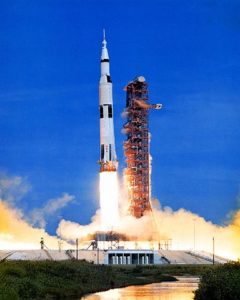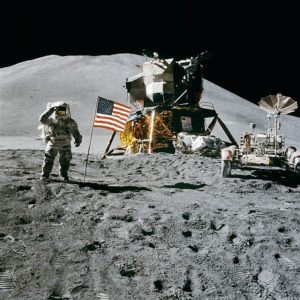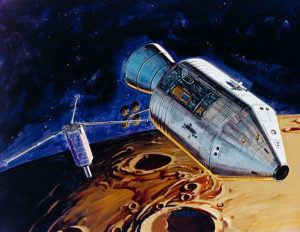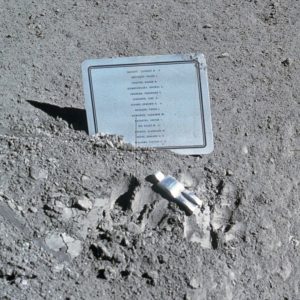It was 45 years ago today that the 4th manned lunar landing took place. Hadley Rille, a geographically intriguing area of the lunar surface, was chosen as the landing site due to the possible volcanic origins of the region, with the rille area itself being likely one of the best areas to gather samples from.
Launched on July 26th, 1971, Apollo 15 was the first of the “J” class missions, where crews would spend up to 3 days on the lunar surface. These missions were the real goal of project Apollo from a scientific perspective. While the political goal of beating the Soviet Union to the moon had been accomplished with the legendary landing of Apollo 11, later missions were all designed to take advantage of this capability to learn more about the Moon, and by extension, Earth, through geological research.

The launch of Apollo 15
Apollo 15 was originally going to be another H class mission, much like Apollo 12 and 14, but with the budget cuts and cancellations of Apollo missions 18 and 19, the final 3 missions were moved up to extended stay J class missions, to maximize our time on the moon itself. Apollo was beginning to wind down, and the scientists who had spent the past decade making it a reality wanted to make sure the chance for knowledge was taken full advantage of.

Irwin, the American Flag, the Lunar Rover, and the LM Falcon in the rear, at Hadley Rille
Apollo 15 was the first mission to carry the Lunar Rover, extending the exploration range of the crews far beyond that of previous missions. Additional equipment was carried on the CSM to scan the lunar surface and the space around the Moon, as well as launch a small subsatellite, PFS-1, to study the environment immediately around the Moon, and the lunar gravitational field.

Artists depiction of the release of PFS-1
David Scott and Lames Irwin would spend almost 20 hours walking on the moon over 4 separate EVA’s. They would spend nearly 3 days on the Moon, and the entire mission would last 12 days. Al Worden, Command Module Pilot, would orbit the moon over 70 times while his crew mates conducted lunar operations.
The crew brought back over 170 lbs of lunar material, including one of the oldest known rocks in the universe, known as the Genesis Rock, dating back to near the formation of the solar system 4.5 billion years ago.
Apollo 15 would also leave something special on the moon. A small, aluminum sculpture of an astronaut, left with a plaque displaying the names of 14 Astronauts and Cosmonauts who were known at that time to have died in the quest for space flight.
After leaving Lunar orbit, Al Worden would conduct the first deep space EVA to collect film from the scientific package on the service module of the Apollo spacecraft. Apollo 15 would return home on 7th after 12 days in space, and was regarded by NASA as quite possibly the most successful space flight ever, considering the amount of material brought back and the data gathered.
Check out this NASA film on the mission, and as always, the additional links below. There is so much more to the story of this flight than I can put into an easy to digest article. Enjoy!

